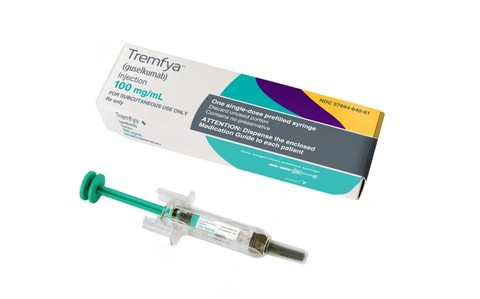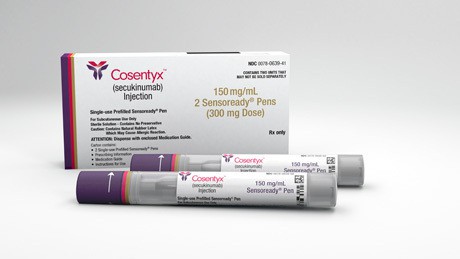Novartis’ Cosentyx can put some of its fast growth in psoriasis down to data showing it was more effective than Johnson & Johnson’s widely-used Stelara, but a new trial has tried to turn that tale on its head.
In a head-to-head challenge, J&J’s recently approved follow-up to Stelara (ustekinumab) – Tremfya (guselkumab) – was found to be superior to Cosentyx (secukinumab) in the treatment of adults with moderate-to-severe plaque psoriasis, with the company claiming its drug was more effect in clearing the skin, worked more quickly and seemed to be effective for longer.

J&J’s Tremfya
The ECLIPSE trial showed that 84.5% of patients treated with Tremfya achieved at least 90% improvement from baseline in their Psoriasis Area Severity Index (PASI) score at week 48, compared with 70% of those taking Cosentyx.
“Maximum response rates with Tremfya are achieved after six months and are maintained over time through one year, achieving superiority at the primary endpoint of the study,” said lead study investigator Richard Langley of Dalhousie University in the US.
The data “confirm a slightly more rapid onset of response with Cosentyx, but importantly, in a chronic disease like psoriasis, these data provide new insights into comparative longer-term efficacy,” he added.

Novartis’ Cosentyx
The two drugs both treat psoriasis by targeting interleukins involved in the inflammatory process, with Cosentyx targeting IL-17 and Tremfya inhibiting IL-23, and are among a clutch of new biologic therapies elbowing for market share in the increasingly crowded psoriasis category.
Whether the Tremfya data can slow down the fast growth of Cosentyx and accelerate Tremfya’s take-up remains to be seen – particularly as the two drugs were equivalent however when it came to 75% and 100% PASI improvements in ECLIPSE.
Cosentyx was the first IL-17 inhibitor to reach the market and, while it has since been joined by rivals from Eli Lilly (Taltz) and Valeant (Siliq), is well ahead in the market with sales topping $2bn in the first nine months of 2018.
In the meantime, Stelara, which targets both IL-23 and IL-12, has proved remarkably resistant to competition from the new entrants with nine-month sales growing at almost 27% to reach $3.7bn, thanks to a shift into new territory including the adolescent psoriasis population.
That strength is critical for J&J, given that Tremfya still in the rollout phase following its launch last year and its earlier-generation drug for psoriasis and other inflammatory diseases Remicade (infliximab) facing increasing competition from biosimilars.
TNF inhibitor Remicade’s sales fell by around 15% in the first nine months of the year to $4.1bn, mainly due to price reductions, while Tremfya sales were $369m globally in that period, with J&J claiming a 5.8% market share in the US.




